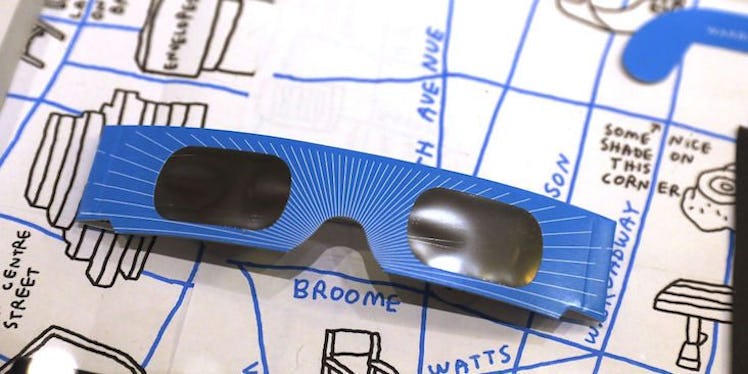
Even If You Waited Until The Last Minute, You Can Still Make Solar Eclipse Glasses
Hopping on the eclipse bandwagon but can't find yourself a pair of those snazzy goggles to protect your eyes? (Yes, looking at the sun during an eclipse can cause serious eye damage, so don't try it.) We've got all you procrastinators covered with this guide on how to make last-minute solar eclipse glasses.
A guide in The Washington Post offers plenty of ideas for those who are crafty to those who don't own a pair of scissors.
The simplest, cheapest way to view the eclipse is to create a projector. (Repeat: This does not mean looking at the sun, as you would with actual eclipse glasses.) You can safely view the eclipse with an object with lots of holes for light to pass through, like a cheese grater or colander. (One person on Twitter has even recommended a Ritz cracker.) The NASA eclipse guide explains how to view the eclipse by cross-hatching your fingers to create a webbing or waffle pattern:
With your back to the sun, look at your hands' shadow on the ground. The little spaces between your fingers will project a grid of small images on the ground, showing the sun as a crescent during the partial phases of the eclipse.
(Again, note that your back should be to the sun; you'll be watching the action via the shadow the object casts on the ground.)
The craftier among us may be inspired to make a pinhole camera or pinhole projector. Basically, this super-simple technology works by allowing light to enter into a very small hole in a dark environment (in this case, a box) and projecting that light onto a viewable surface. Then, you're looking at a "screen" with a real-time mirror image of the sun rather than directly at it. (Think of a movie theater: You sit watching the screen, but the projector behind you is where all the light's coming from.)
Here's what you need: cereal box, aluminum foil, white paper, tape, push pin or pen, and scissors.
Place the box on top of the paper right-side up, trace around the bottom rectangle, and cut it out. Using tape, affix the paper rectangle to the inside of the bottom panel of the box. Next, close the box so no light gets in.
On the top of the box (opposite end), make two small holes or squares, about an inch or so wide. Cover one hole with foil; once taped down, create a small hole with a push pin in the foil.
The other hole will be where you look through. The sun's reflection should appear on the white paper panel on the bottom of the box. Remember, turn your back to the sun when you look into the box, so that the light can enter through the pinhole. That's it!
If you've already scored a pair of certifiable, legit eclipse-viewable sunglasses, feel free to verify their authenticity by checking NASA's ISO or reputable manufacturer list. Also, while not a foolproof test, put on your glasses indoors and look toward a turned-on light, such as a lamp. If your eclipse glasses are the real deal, normal indoor lights won't be visible said an expert interviewed in The Register-Guard.
Whatever you do, make sure you enjoy this once-in-a-lifetime experience with adequate eye protection.